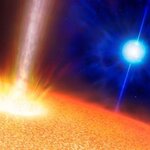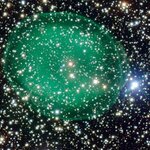Space

A new type of exceptionally powerful and long-lived cosmic explosion, powerful blasts of high energy gamma-rays, known as gamma-ray bursts, that lasts hours rather than the more common minute, may mean a new hypothesis; that they arise in the violent death throes of a supergiant star.
The first example astronomers found was on December 25th, 2010, but it lacked a measurement of distance and so remained shrouded in mystery, with two competing ideas put forward for its origin. The first model suggested it was down to an asteroid, shredded by the gravity of a dense neutron star in our…

NOAA's Space Weather Prediction Center is the official U.S Government source for space weather forecasts, alerts, watches and warnings. NASA and NOAA,as well as the US Air Force Weather Agency (AFWA) and others, keep a constant watch on the sun to monitor for space weather effects such as geomagnetic storms, the idea being that with advance notification many satellites, spacecraft and technologies can be protected from the worst effects. They got to witness a doozy today; an M6.5 flare on the morning which was also associated with an Earth-directed coronal mass ejection (CME).…

Our sun will one day become a faint white dwarf star - but prior to that, for a few tens of thousands of years as its atmosphere is blown away into space it could be surrounded by spectacular and colorful glowing clouds of ionized gas known as planetary nebulae.
The Sun is 4.6 billion years old and it will likely live another four billion years but stars with masses like the Sun (and up to eight times that of the Sun) will form planetary nebulae as they enter the final phase of their existence. We know this because we can observe the planetary nebula IC 1295, which lies in the…

A couple of news stories related to NASA. One is that there will be money in the NASA FY14 budget to send astronauts to an asteroid and bring it back to (?) Earth. The other study is that NASA Administrator Bolden boldly stated:
http://www.spacepolitics.com/
“NASA will not take the lead on a human lunar mission,” he said.
“NASA is not going to the Moon with a human as a primary project
probably in my lifetime. And the reason is, we can only do so many
things.” Instead, he said the focus would remain on human missions to
asteroids and to Mars. “We intend to do that, and we think it can be
done…

A team of astronomers led by the International Centre for Radio Astronomy Research (ICRAR) have succeeded in observing the death throws of a giant star in unprecedented detail.
In February of 1987 astronomers were observing the nearby dwarf galaxy known as the Large Magellanic Cloud when they discovered what looked like a new star.
It wasn't new, instead it was the end of one and it was the brightest supernova seen from Earth in the four centuries since the telescope was invented. By the next morning news of the discovery had spread across the globe and southern hemisphere stargazers…

Most stars do not form in isolation, but are in clusters ranging from dozens to thousands of stars.
Even in our galaxy, the Milky Way, with stars more than 13 billion years old, has a lot of young, hot action: new objects form and others are destroyed. NGC 2547 is an example.
How young is young, cosmically? Considering that our Sun is 4.6 billion years old and has not yet reached middle age, NGC 2547's stars ranging from 20 to 35 million years old is really young. If you imagine that our Sun as a 40 year-old person, the bright stars in the picture below are three-month-old…

The most detailed map ever created of the cosmic microwave background – the relic radiation from the Big Bang – found something a little odd.
The information extracted from Planck’s new map provides an excellent confirmation of the standard model of cosmology at an unprecedented accuracy, setting a new benchmark in our manifest of the contents of the Universe - but because precision of Planck’s map is so high, it also made it possible to reveal some peculiar unexplained features that may well require new physics to be understood.
The image is based on the initial 15.5 months of data…

Electrically charged lunar dust near shadowed craters can get lifted above the surface and 'jump' over the shadowed region, bouncing back and forth between sunlit areas on opposite sides.
This effect should be especially prominent during dusk and dawn, according to the researchers behind the calculations, as regions become partially illuminated while features like mountains and crater rims cast long shadows.
To our eyes, the moon has no apparent activity and seems dead. However, because it has almost no atmosphere, the moon is exposed to the solar wind, a thin stream of…

On Jupiter, cloudless patches are so rare that the larger visible ones get the special name 'hot spots.'
How do these clearings form and why they are they only found near the planet's equator?
It's a mystery, by Jove, but using images from the Cassini spacecraft, scientists have found new evidence that hot spots in Jupiter's atmosphere are created by a Rossby wave, a pattern also seen in Earth's atmosphere and oceans. The team found the wave responsible for the hot spots glides up and down through layers of the atmosphere like a carousel horse on a merry-go-round.
"This is the first time…

A team of international scientist has made the most detailed examination yet of the atmosphere of a Jupiter-size like planet beyond our solar system.
The planet is one of four gas giants known to orbit a star called HR 8799, 130 light-years from Earth. The authors and their collaborators previously discovered this planet, designated HR 8799c, and its three companions back in 2008 and 2010. Unlike most other planetary systems, whose presence is inferred by their effects on their parent star, the HR8799 planets can be individually seen.
The team, using the OSIRIS instrument on the…